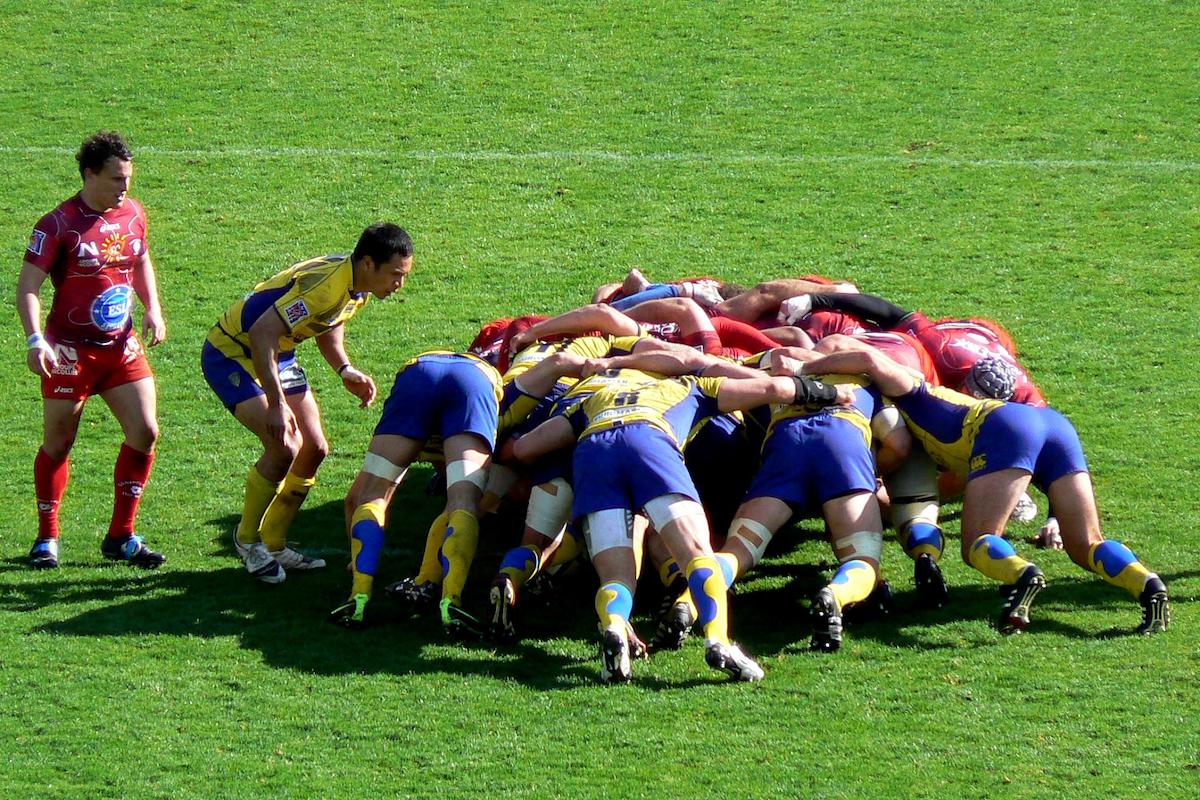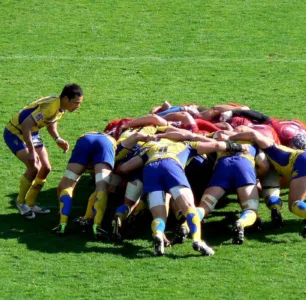In rugby, the term “back row” refers to the three players who occupy the positions of flanker and number eight. These players are responsible for providing support to the forwards during set pieces like scrums and lineouts, as well as being involved in open play and defense.
When the term “balanced back row” is used, it usually refers to a back row combination where the three players have complementary skills and abilities. This means that each player is able to contribute in different ways to the team’s overall performance.
For example, a balanced back row might consist of a specialist open-side flanker who excels at winning turnovers and disrupting opposition attacks, a strong ball-carrying number eight who can make significant gains with the ball in hand, and a blind-side flanker who is an effective tackler and lineout jumper.
A balanced back row is important because it allows a team to cover all aspects of the game effectively, whether that’s attacking, defending, or winning possession. If the back row is unbalanced, it can leave the team vulnerable in certain areas and make it harder to compete against opponents who have a more balanced set of players in those positions.
What is the role of a no 6
In rugby, the position of No. 6 refers to the blindside flanker, who typically wears the number 6 jersey. The No. 6 is one of the three players in the back row, along with the openside flanker (No. 7) and the number eight (No. 8).
The role of the No. 6 in rugby is primarily focused on defense and support play. The blindside flanker is responsible for:
- Tackling: The No. 6 is expected to make tackles all over the field, with a particular focus on stopping opposition attacks on the blindside of the scrum or breakdown.
- Rucking: The No. 6 is also expected to support his teammates in the ruck by securing possession for his team and disrupting the opposition’s attempts to do the same.
- Lineout jumping: The No. 6 is often one of the tallest and most athletic players on the team, which makes him an ideal target for lineout throws. He is responsible for jumping to catch the ball, and for competing with the opposition for possession.
- Ball carrying: While the No. 6 is not the primary ball carrier on the team, he is expected to carry the ball forward when the opportunity arises, and to be an effective link player between the forwards and backs.
Overall, the role of the No. 6 is to provide a physical and defensive presence on the field, while also contributing to the team’s attacking play when necessary. The No. 6 is a crucial member of the team, and his ability to dominate the physical contests can be a major factor in the outcome of the game.
Openside flankers role
In rugby, the openside flanker (No. 7) is a member of the back row and typically wears the number 7 jersey. The role of the openside flanker is diverse and requires a range of skills and abilities.
The primary role of the openside flanker is to disrupt the opposition’s play and win turnovers. Some of the key responsibilities of the openside flanker include:
- Tackling: The openside flanker is an important tackler and is expected to make a high number of tackles throughout the match.
- Winning turnovers: The openside flanker is known as the “fetcher” because of their ability to get to the breakdown quickly and win turnovers by either stealing the ball or forcing penalties. This is a crucial skill in modern rugby, as turnovers can lead to quick attacking opportunities.
- Supporting the attack: The openside flanker is also expected to be an effective support player in attack. This includes making runs with the ball, passing, and supporting ball carriers in contact situations.
- Defending the fringes: The openside flanker is responsible for defending the fringes of the ruck and maul, as well as covering the opposition’s halfback in defense.
- Lineout jumping: The openside flanker may also be involved in lineout jumping, especially in the case of a shortened lineout, where only two players jump for the ball.
Overall, the openside flanker is a key player in rugby who contributes to both the attacking and defensive aspects of the game. They are known for their tenacity, athleticism, and ability to win turnovers, making them a valuable asset to any team.
What is the number 8’s role in rugby
In rugby, the number 8 (No. 8) is a member of the back row and typically wears the number 8 jersey. The role of the number 8 is focused on ball carrying, supporting the scrum, and providing a link between the forwards and backs. Their ability to carry the ball and support the scrum is crucial to the team’s success, and their role as a link player between the forwards and backs helps to create attacking opportunities.
The primary responsibilities of the number 8 in rugby include:
- Ball carrying: The number 8 is one of the key ball carriers on the team, and is expected to make strong runs with the ball, break through tackles, and gain ground for the team.
- Supporting the scrum: The number 8 is positioned at the back of the scrum, and is responsible for controlling the ball when it is fed into the scrum by the scrum-half. The number 8 is also responsible for providing extra weight and stability to the scrum.
- Supporting the lineout: The number 8 may also be involved in the lineout, either as a jumper or as a player who supports the jumpers.
- Linking with the backs: The number 8 is expected to be a versatile player who can pass the ball, make offloads, and support the backs in attack. They are often involved in setting up attacking moves and creating space for the backs.
- Defense: The number 8 is also responsible for making tackles and disrupting opposition attacks. They must be able to defend in both tight and open play situations.
How do the three positions compliment each other
The three positions of the back row in rugby – No. 6 (blindside flanker), No. 7 (openside flanker), and No. 8 – are interdependent and work together to create a balanced and effective unit. Each position has its specific roles and responsibilities, and when combined, they can provide a strong and cohesive back row that can dominate the opposition.
The way that the three positions complement each other can be seen in several ways:
Defense
The No. 6 is typically a strong tackler who can stop opposition attacks on the blindside of the scrum or breakdown, while the No. 7 is often the “fetcher” who can win turnovers and disrupt the opposition’s play. The No. 8 can provide support in both of these areas, as well as defending the fringes of the ruck and maul.
Attack
The No. 8 is often the primary ball carrier who can break tackles and gain ground, while the No. 6 can be an effective link player who can pass the ball and create space for the backs. The No. 7’s ability to win turnovers and quickly transition from defense to attack can also be a valuable asset in creating attacking opportunities.
Set pieces
The No. 6 and No. 7 are often involved in the lineout, either as jumpers or support players, while the No. 8 provides extra weight and stability to the scrum.
Physicality
The No. 6 and No. 7 are typically smaller and more agile than the No. 8, who is often larger and more powerful. This balance of physicality can make the back row difficult to stop, as each player can bring a different type of physicality to the game.
Overall, the three positions of the back row work together to provide a balanced and effective unit that can dominate the opposition. Their ability to complement each other’s strengths and weaknesses can be a major factor in the outcome of the game.

